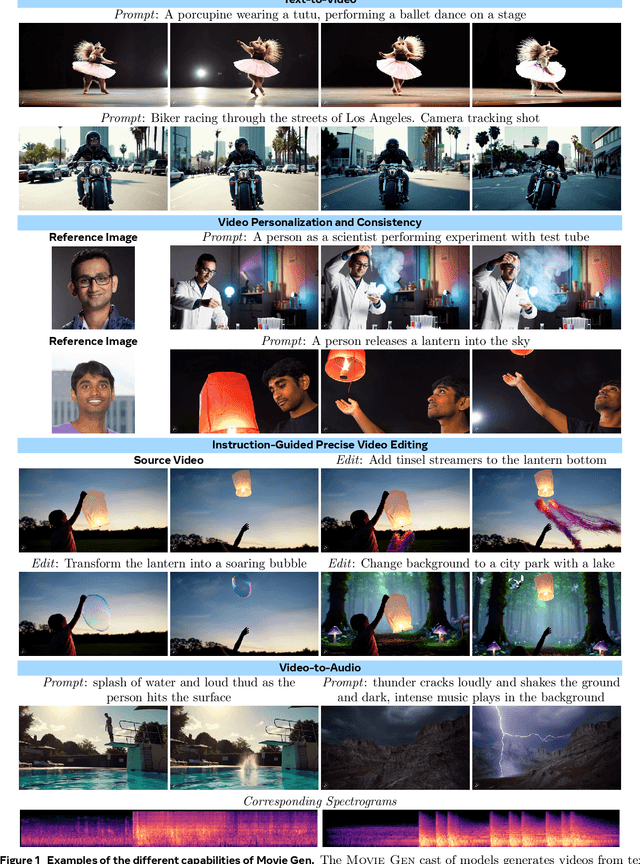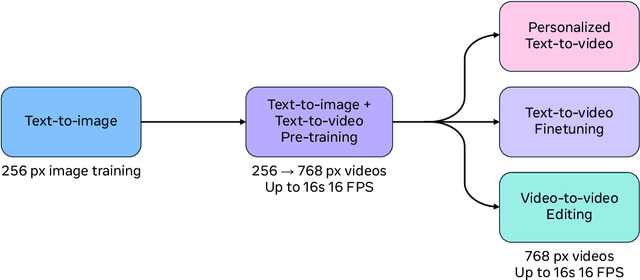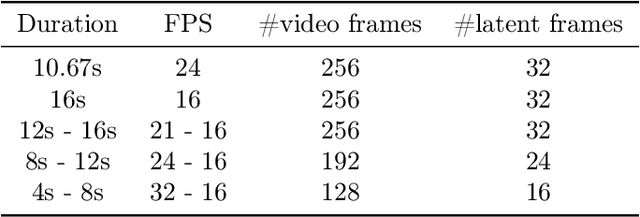Matt Le
Meta Audiobox Aesthetics: Unified Automatic Quality Assessment for Speech, Music, and Sound
Feb 07, 2025



Abstract:The quantification of audio aesthetics remains a complex challenge in audio processing, primarily due to its subjective nature, which is influenced by human perception and cultural context. Traditional methods often depend on human listeners for evaluation, leading to inconsistencies and high resource demands. This paper addresses the growing need for automated systems capable of predicting audio aesthetics without human intervention. Such systems are crucial for applications like data filtering, pseudo-labeling large datasets, and evaluating generative audio models, especially as these models become more sophisticated. In this work, we introduce a novel approach to audio aesthetic evaluation by proposing new annotation guidelines that decompose human listening perspectives into four distinct axes. We develop and train no-reference, per-item prediction models that offer a more nuanced assessment of audio quality. Our models are evaluated against human mean opinion scores (MOS) and existing methods, demonstrating comparable or superior performance. This research not only advances the field of audio aesthetics but also provides open-source models and datasets to facilitate future work and benchmarking. We release our code and pre-trained model at: https://github.com/facebookresearch/audiobox-aesthetics
Flow Matching Guide and Code
Dec 09, 2024Abstract:Flow Matching (FM) is a recent framework for generative modeling that has achieved state-of-the-art performance across various domains, including image, video, audio, speech, and biological structures. This guide offers a comprehensive and self-contained review of FM, covering its mathematical foundations, design choices, and extensions. By also providing a PyTorch package featuring relevant examples (e.g., image and text generation), this work aims to serve as a resource for both novice and experienced researchers interested in understanding, applying and further developing FM.
Movie Gen: A Cast of Media Foundation Models
Oct 17, 2024



Abstract:We present Movie Gen, a cast of foundation models that generates high-quality, 1080p HD videos with different aspect ratios and synchronized audio. We also show additional capabilities such as precise instruction-based video editing and generation of personalized videos based on a user's image. Our models set a new state-of-the-art on multiple tasks: text-to-video synthesis, video personalization, video editing, video-to-audio generation, and text-to-audio generation. Our largest video generation model is a 30B parameter transformer trained with a maximum context length of 73K video tokens, corresponding to a generated video of 16 seconds at 16 frames-per-second. We show multiple technical innovations and simplifications on the architecture, latent spaces, training objectives and recipes, data curation, evaluation protocols, parallelization techniques, and inference optimizations that allow us to reap the benefits of scaling pre-training data, model size, and training compute for training large scale media generation models. We hope this paper helps the research community to accelerate progress and innovation in media generation models. All videos from this paper are available at https://go.fb.me/MovieGenResearchVideos.
Learning Fine-Grained Controllability on Speech Generation via Efficient Fine-Tuning
Jun 10, 2024Abstract:As the scale of generative models continues to grow, efficient reuse and adaptation of pre-trained models have become crucial considerations. In this work, we propose Voicebox Adapter, a novel approach that integrates fine-grained conditions into a pre-trained Voicebox speech generation model using a cross-attention module. To ensure a smooth integration of newly added modules with pre-trained ones, we explore various efficient fine-tuning approaches. Our experiment shows that the LoRA with bias-tuning configuration yields the best performance, enhancing controllability without compromising speech quality. Across three fine-grained conditional generation tasks, we demonstrate the effectiveness and resource efficiency of Voicebox Adapter. Follow-up experiments further highlight the robustness of Voicebox Adapter across diverse data setups.
Guided Flows for Generative Modeling and Decision Making
Dec 07, 2023Abstract:Classifier-free guidance is a key component for enhancing the performance of conditional generative models across diverse tasks. While it has previously demonstrated remarkable improvements for the sample quality, it has only been exclusively employed for diffusion models. In this paper, we integrate classifier-free guidance into Flow Matching (FM) models, an alternative simulation-free approach that trains Continuous Normalizing Flows (CNFs) based on regressing vector fields. We explore the usage of \emph{Guided Flows} for a variety of downstream applications. We show that Guided Flows significantly improves the sample quality in conditional image generation and zero-shot text-to-speech synthesis, boasting state-of-the-art performance. Notably, we are the first to apply flow models for plan generation in the offline reinforcement learning setting, showcasing a 10x speedup in computation compared to diffusion models while maintaining comparable performance.
Generative Pre-training for Speech with Flow Matching
Oct 25, 2023Abstract:Generative models have gained more and more attention in recent years for their remarkable success in tasks that required estimating and sampling data distribution to generate high-fidelity synthetic data. In speech, text-to-speech synthesis and neural vocoder are good examples where generative models have shined. While generative models have been applied to different applications in speech, there exists no general-purpose generative model that models speech directly. In this work, we take a step toward this direction by showing a single pre-trained generative model can be adapted to different downstream tasks with strong performance. Specifically, we pre-trained a generative model, named SpeechFlow, on 60k hours of untranscribed speech with Flow Matching and masked conditions. Experiment results show the pre-trained generative model can be fine-tuned with task-specific data to match or surpass existing expert models on speech enhancement, separation, and synthesis. Our work suggested a foundational model for generation tasks in speech can be built with generative pre-training.
On Kinetic Optimal Probability Paths for Generative Models
Jun 11, 2023Abstract:Recent successful generative models are trained by fitting a neural network to an a-priori defined tractable probability density path taking noise to training examples. In this paper we investigate the space of Gaussian probability paths, which includes diffusion paths as an instance, and look for an optimal member in some useful sense. In particular, minimizing the Kinetic Energy (KE) of a path is known to make particles' trajectories simple, hence easier to sample, and empirically improve performance in terms of likelihood of unseen data and sample generation quality. We investigate Kinetic Optimal (KO) Gaussian paths and offer the following observations: (i) We show the KE takes a simplified form on the space of Gaussian paths, where the data is incorporated only through a single, one dimensional scalar function, called the \emph{data separation function}. (ii) We characterize the KO solutions with a one dimensional ODE. (iii) We approximate data-dependent KO paths by approximating the data separation function and minimizing the KE. (iv) We prove that the data separation function converges to $1$ in the general case of arbitrary normalized dataset consisting of $n$ samples in $d$ dimension as $n/\sqrt{d}\rightarrow 0$. A consequence of this result is that the Conditional Optimal Transport (Cond-OT) path becomes \emph{kinetic optimal} as $n/\sqrt{d}\rightarrow 0$. We further support this theory with empirical experiments on ImageNet.
Flow Matching for Generative Modeling
Oct 06, 2022



Abstract:We introduce a new paradigm for generative modeling built on Continuous Normalizing Flows (CNFs), allowing us to train CNFs at unprecedented scale. Specifically, we present the notion of Flow Matching (FM), a simulation-free approach for training CNFs based on regressing vector fields of fixed conditional probability paths. Flow Matching is compatible with a general family of Gaussian probability paths for transforming between noise and data samples -- which subsumes existing diffusion paths as specific instances. Interestingly, we find that employing FM with diffusion paths results in a more robust and stable alternative for training diffusion models. Furthermore, Flow Matching opens the door to training CNFs with other, non-diffusion probability paths. An instance of particular interest is using Optimal Transport (OT) displacement interpolation to define the conditional probability paths. These paths are more efficient than diffusion paths, provide faster training and sampling, and result in better generalization. Training CNFs using Flow Matching on ImageNet leads to state-of-the-art performance in terms of both likelihood and sample quality, and allows fast and reliable sample generation using off-the-shelf numerical ODE solvers.
Facebook AI's WAT19 Myanmar-English Translation Task Submission
Oct 15, 2019



Abstract:This paper describes Facebook AI's submission to the WAT 2019 Myanmar-English translation task. Our baseline systems are BPE-based transformer models. We explore methods to leverage monolingual data to improve generalization, including self-training, back-translation and their combination. We further improve results by using noisy channel re-ranking and ensembling. We demonstrate that these techniques can significantly improve not only a system trained with additional monolingual data, but even the baseline system trained exclusively on the provided small parallel dataset. Our system ranks first in both directions according to human evaluation and BLEU, with a gain of over 8 BLEU points above the second best system.
The Source-Target Domain Mismatch Problem in Machine Translation
Sep 28, 2019



Abstract:While we live in an increasingly interconnected world, different places still exhibit strikingly different cultures and many events we experience in our every day life pertain only to the specific place we live in. As a result, people often talk about different things in different parts of the world. In this work we study the effect of local context in machine translation and postulate that particularly in low resource settings this causes the domains of the source and target language to greatly mismatch, as the two languages are often spoken in further apart regions of the world with more distinctive cultural traits and unrelated local events. In this work we first propose a controlled setting to carefully analyze the source-target domain mismatch, and its dependence on the amount of parallel and monolingual data. Second, we test both a model trained with back-translation and one trained with self-training. The latter leverages in-domain source monolingual data but uses potentially incorrect target references. We found that these two approaches are often complementary to each other. For instance, on a low-resource Nepali-English dataset the combined approach improves upon the baseline using just parallel data by 2.5 BLEU points, and by 0.6 BLEU point when compared to back-translation.
 Add to Chrome
Add to Chrome Add to Firefox
Add to Firefox Add to Edge
Add to Edge